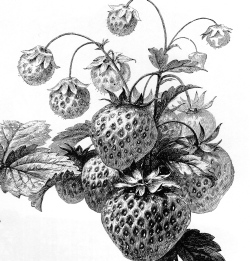Strawberry fool
Fools are fun. They resemble a sort of primitive ice cream; they also are simple to make and summery, although, as britishfoodinamerica has noted, winter fools may be made with dried or (some) canned fruit. The foundational English fool uses gooseberries but any soft fruit will do. The Editor’s family and friends most often ask for strawberry, however, so that is her template fool. This recipe makes six generous fools.
 -1 lb trimmed strawberries, cut into smallish pieces
-1 lb trimmed strawberries, cut into smallish pieces
-sugar; the amount depends on the succulence of your fruit and your taste, but you will want some
-about 1 cup heavy or whipping cream
- Cook the berries and sugar over medium high heat until the fruit softens, about 10 minutes.
- Mash the berries or puree them in a food mill or processor (but see notes) and let the fruit cool.
- Whip the cream (the addition of a little sugar will help it loft) until it thickens a little; you need not go to town.
- Gently fold the cooled fruit into the thickened cream, spoon the fool into six attractive glasses for individual service, cover the fools with plastic and chill them for a couple of hours or overnight before serving.
Notes:
- Try not to overload the sugar: A fool should be tangier than sweet.
- There are two main schools of fools and a number of lesser academies. Most authors puree their fools but Jane Grigson demurs:
- “Do not try to produce a smooth puree--unless you have to consider elderly people with false teeth--by sieving or liquidising the goose [or straw, or other, berries]; they should be more of a mash.” (English Food, London 1974, 256)
- The Editor sides with Mrs. Grigson but her unscientific and statistically insignificant anecdotal survey indicates that most people do not.
- Our Rural Correspondent laces his fool with custard. He uses Bird’s powdered or readymade custard, a product despised by the self-appointed fool police even though it is not at all bad. Go ahead and find Bird’s at an expat shop or the ‘Irish’ section of bigger American supermarkets if you are either afraid of cooking custard or are strapped for time and want a custardy fool. Either substitute the custard for the cream or use them in equal proportion. If you would like to make custard, our version appears with the recipe for strawberry fool.
- A ‘fool’ resembling a sort of wrecked trifle or rolypoly that is made with jam appears in Maura Laverty’s Cookbook. (New York 1947) It purports to be Irish and would be a wintertime expedient:
“Beat into 2 1/3 [sic] cups of custard as much sponge or cake crumbs as it will take. Add 4 tablespoons raspberry or strawberry jam. Whipped cream makes a nice addition, but the dish is good without it. Serve it in custard glasses with a spot of jam on each.”
- It is not a bad idea to boost a conventional fool, especially if your berries are imperfectly ripe, by adding a dollop of strawberry jam to the fruit instead of sugar when you cook it.
- The best of all commercial strawberry jams is Tiptree’s Little Scarlet strawberry conserve. It is expensive, but if you dole it out stingily to boost your fools it is decent value for money.
- As bfia’s own Charles Burling previously has noted in the lyrical, British usage describes jam made from domestic fruit as ‘conserves’ and jam made from imported fruit as ‘preserves.’ Look for British conserves made from peerless English berries.
- Fools traditionally are served with ladyfingers or plain cookies. The Editor likes gingersnaps with strawberry fool, but then she likes any excuse to eat gingersnaps.
- For a richer fool, try stewing the fruit in a little unsalted butter; nnecessary, excessive and appealing in its decadence.
- Never add water to the berries. They should not scorch without it; if you get anxious, reduce the heat instead of diluting the fruit.

